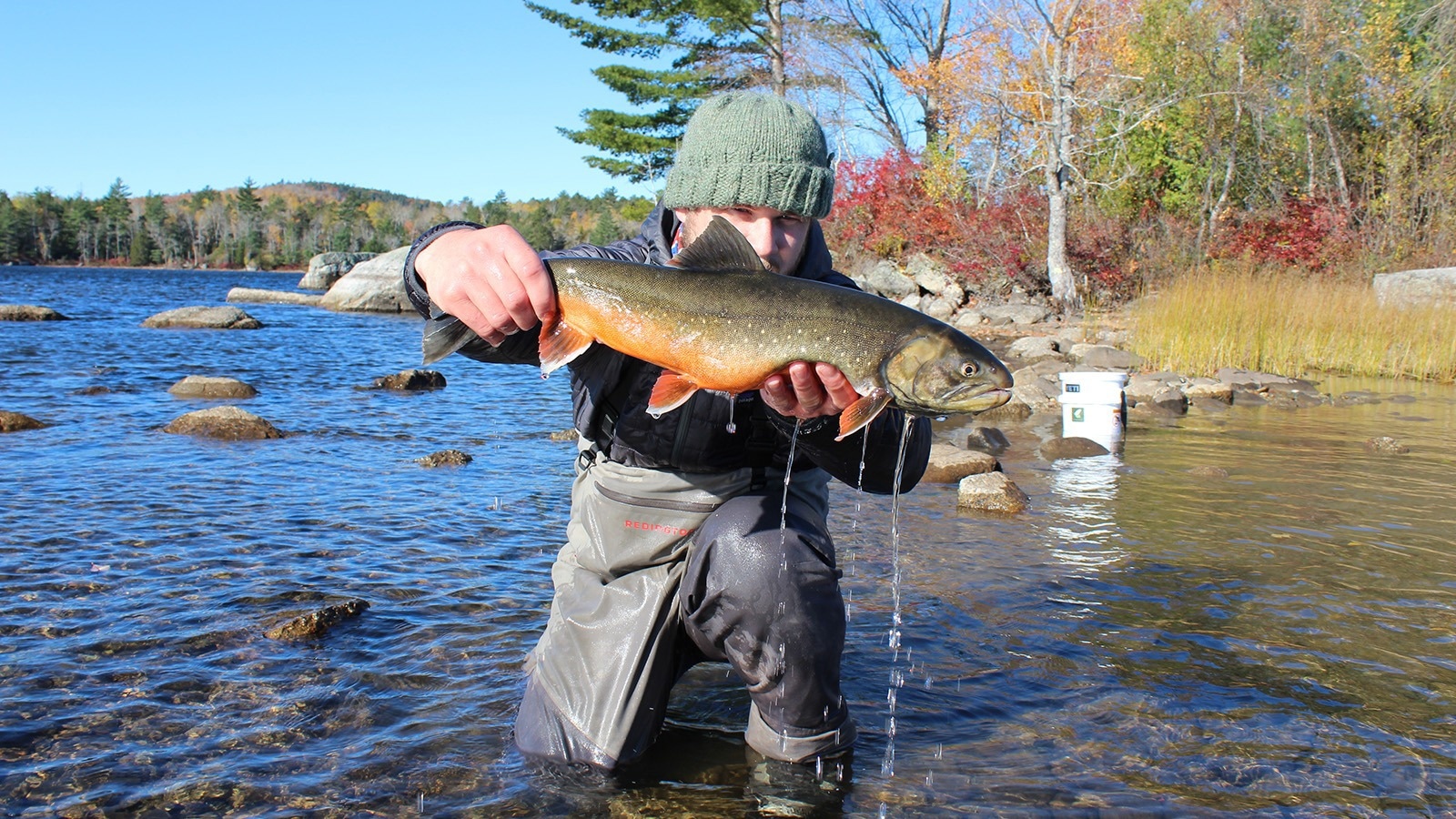Reviewed by Alex SmithAug 3 2022
Researchers from the Universities of Maine and New Hampshire will look into how the diversity and development of feeding strategies among Arctic charr populations in Maine impact their vulnerability or resilience to climate change.
 Photo of former University of Maine graduate student Mitch Paisker releasing a female Arctic charr that was captured, tagged and measured back into Floods Pond in 2018. Image Credit: Bradley Erdman.
Photo of former University of Maine graduate student Mitch Paisker releasing a female Arctic charr that was captured, tagged and measured back into Floods Pond in 2018. Image Credit: Bradley Erdman.
Nathan Furey, an assistant professor of biological sciences at UNH, Michael Kinnison, a professor of evolutionary applications at UMaine, and Christina Murphy, an assistant professor with the UMaine Department of Wildlife, Fisheries, and Conservation Biology and assistant unit leader of Maine’s US Geological Survey, collaborated on the study.
The National Science Foundation’s Organismal Responses to Climate Change Program awarded almost $1.5 million for the research.
The new study will be supported by data that Kinnison’s lab has gathered over a 20-year period from Arctic charr genetic samples, phenotypic data, and mark-recapture population size estimations from Floods Pond in Otis, Maine.
After the glaciers retreated more than 10,000 years ago, Arctic charr began to populate several lakes in Maine, Vermont, and New Hampshire. The only remaining native populations of Arctic charr in the United States outside of Alaska are found in Maine, according to the Maine Department of Inland Fisheries and Wildlife (MDIFW). Populations in New Hampshire and Vermont went extinct in the past century.
Anglers and environmentalists alike highly value this special natural treasure, sometimes known as “blueback” or “Sunapee” trout, but Maine’s only remaining populations also represent the most southern populations of this Arctic species, putting them at particular risk from climate change.
These populations now differ in what and where they eat, how big they get, when they spawn, and in which habitats, according to an earlier study by Kinnison’s team. The researchers from UMaine and UNH hypothesize that these variations are related to variations in the availability of food resources in the lakes.
Additionally, they claim that there is proof from an introduced population that Arctic charr feeding habits and attributes can alter over the course of years or even decades as the availability of food and other resources changes.
Global food webs are in danger due to climate change. However, the researchers found that many predictive models for species responses do not take into consideration the variation and development of feeding strategies across populations of some animals that are on the periphery of their biological ranges, such as Arctic charr in Maine.
The UMaine and UNH researchers say they will fill the gap by creating a framework that connects the genetic and malleable elements of the diversity of feeding traits in Arctic charr in Maine to “population demography, habitat, community contexts, and ultimately the eco-evolutionary potential for persistence” against climate change.
The teams research could help strengthen our understandings to enable us to better predict the viability of Maine Arctic charr and other species with populations that are at the peripheral of their ecological ranges based on the combined factors of inter- and intraspecies interactions like competition, different phenotypes like eating habits and climate change.
Maine’s woods and waters are the front lines for climate change. Many of Maine’s iconic species, from moose, to loons, to salmon and Arctic charr are literally living on the edge—their warm range edge.
Michael Kinnison, Professor, Evolutionary Applications, University of Maine
Kinnison, who directs the Maine Center for Genetics in the Environment adds, “We think the winners and losers will often come down to which populations can adapt or otherwise match climate-related resource changes. Maine’s Arctic charr are a good system to study this theory and a possibly unique one given our 20-year dataset of fish captures, traits and genetic samples.”
The team will gather non-lethal tissue samples from Arctic charr, other fish, and amphibians in Floods Pond and a few lakes in Maine. These samples will be examined genetically and for naturally occurring isotopes that can be used to identify food webs.
To comprehend the precise behavior of the fish in Floods Pond, they will also use high-resolution fish tracking. This new data will be compared to more than two decades’ worth of fish abundance and trait data from the pond that Kinnison’s students collected in collaboration with the Bangor Water District and MDIFW.
The researchers will utilize their data to create models that represent Arctic charr with a range of feeding behaviors, eating, growing, and enduring across a range of shifting environments, communities, and temperatures.
Furey, Kinnison, and Murphy will collaborate on the project with a postdoctoral researcher, two graduate students, numerous undergraduate students, and technical staff members.
Additionally, based on their research on Arctic charr, the team will collaborate with Laura Wilson, a University of Maine Cooperative Extension 4-H science youth development specialist, to develop science toolkits that will teach elementary school students about how aquatic species adapt to various effects of climate change or perish.
We are really excited about this project because of the multifaceted expertise of the group. Our interdisciplinary approach will not only advance the science, but also be a benefit to the involved students and early career researchers who will gain skills and experience across a breadth of biological disciplines.
Nathan Furey, Assistant Professor, Biological Sciences, University of New Hampshire
Furey concludes, “Combining our unique team with engaged collaborators outside of academia, our work will not only aid the conservation and management of the iconic Arctic charr, but also provide frameworks for identifying resilient populations of other coldwater fishes at their warm range edge as we continue to experience climate change.”